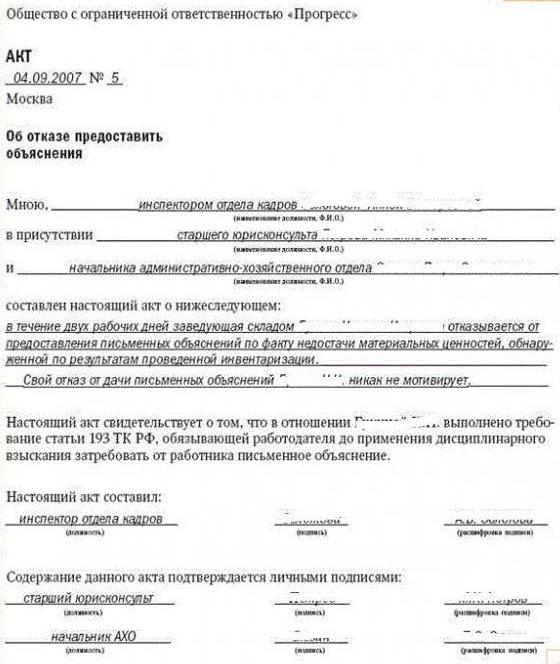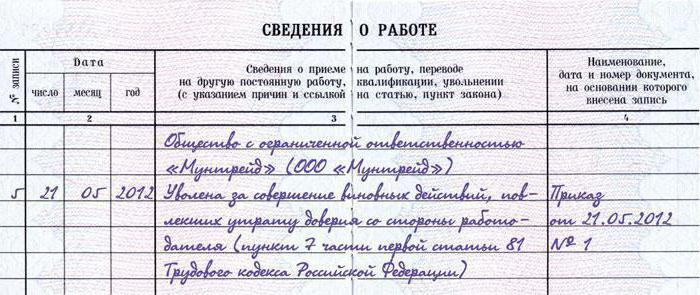Dismissal due to loss of trust is a process prescribed by law, which is a good way to remove an unscrupulous employee. Before using this method of dismissal, you need to think through each step so that no further contentious issues arise.
Basic conditions
When it comes to the dismissal of an employee, where the reason was the loss of confidence (LC RF, Article 81, paragraph 7), this means that there are good reasons for this. The grounds that may serve as the beginning of an investigation into the loss of confidence include:
- The presence of irrefutable evidence of employee actions that led to a loss of confidence. These include theft of property, corruption, neglect of the organization’s property, hiding information about criminal records for economic transactions, etc.
- The presence of documented conditions of service employee material assets of the company or cash. Such conditions are prescribed in the labor agreement, job description and in the liability agreement. The absence of prescribed conditions will allow the employee to easily prove the fact of wrong dismissal.
- If the dismissal due to loss of confidence was due to actions related to the performance of labor duties, then a disciplinary sanction should precede him. The latter should also take place on time.

If we analyze judicial practice, then dismissal due to loss of trust occurs in the following cases:
- harming or attempting to harm the employer (theft, loss, destruction of money or material assets entrusted to the employee);
- violation of the rules of storage, accounting and issuance of money or material assets;
- non-compliance with cash discipline;
- fraudulent write-off of money or material assets;
- use of issued cash or commodity values in their own interests;
- other actions.
In these situations, an investigation by law enforcement authorities or sentencing is not a prerequisite.
Military and public service
There are cases of dismissal due to loss of confidence, when the provisions of not only the above-mentioned article are applied, but you also have to resort to federal legislation regulating the activities of certain professions.
Consider cases of dismissal of persons in public or military service.
When it comes to military personnel, when issuing the order of dismissal, they are also guided by the Regulation on the procedure for performing military service.

Based on part 3, paragraph 1 and paragraph 2, the dismissal of a soldier in connection with the loss of confidence occurs in the following cases:
- Incomplete information on the income and property of the employee and his family is specially provided.
- Private business is being carried out by the employee.
- A non-state company is managed and income from the profit of this company is obtained.
- Failure to take measures to prevent or resolve a conflict situation, in which the employee himself is one of the parties. For the same reason, the commander who knew about this fact and did not take action could be dismissed.
The dismissal of a civil servant in connection with the loss of trust takes place according to a similar scheme, only federal laws such as "On the Prosecutor's Office", "On the Civil Civil Service", "On the Police", etc., enter into force.
The general rule for all categories of employees is compliance with the terms of dismissal, the dismissal process itself and the need to present evidence proving guilt.
Who is not being fired
There are categories of employees to whom dismissal due to loss of trust does not apply. These include:

- a woman in position;
- an employee who is temporarily disabled (here you should wait for the employee to return and carry out the dismissal process);
- a person under the age of majority (the dismissal process can be started if this fact has been agreed with the labor inspectorate and the juvenile commission).
Dismissal process
As mentioned earlier, the Labor Code of the Russian Federation dismissal upon loss of confidence for actions that were committed during the performance of labor duties, determines disciplinary action. Therefore, the termination of the labor agreement must take place on the basis of the procedure established by law.
The order of dismissal in connection with the loss of confidence is as follows:
- Employee action detection.
- Fixation of guilty actions.
- Conducting an internal investigation.
- Obtaining an explanation from the employee in writing (or drawing up a document where a refusal to explain is recorded).
- Drawing up a document on the results of the investigation.
- Issuing an order.
- Record in the work book of dismissal, calculation.
- The immediate dismissal of an employee.
The timing
The legality of the dismissal procedure is determined by compliance with the deadlines established by law.

Duration of termination in case of loss of confidence is one month from the date the misconduct is established. However, this period does not include the following:
- the period when the decision on dismissal is being agreed with the union (if this organization takes place);
- the period when the employee is temporarily disabled.
It should be remembered that the dismissal procedure in connection with the loss of confidence cannot be carried out later than six months from the date of discovery of the perpetrators. An exception may be an misconduct committed as a result of an audit or financial audit. Here the statute of limitations is two years.
An official investigation
The action of the employee that entailed the dismissal due to loss of confidence due to damage or the risk of harm to the material values of the employer should be recorded in an official document. This can be an inventory act, a memo of the head, an act of shortage, etc.
Any of the above documents may provide a basis for initiating an internal investigation. It is intended to confirm the guilt of the employee or to refute it.
The conduct of an internal investigation rests with the specially created commission. It is created through an order for the company, which should contain:
- The reason for the investigation.
- Information about the members of the commission (details, positions, powers).
The commission should include those persons who are not personally interested in the outcome of the investigation, are competent in the matter being examined, and have the opportunity to understand the misconduct.
An organized commission should conduct an audit, request documentation and prepare a report that will be a confirmation of guilt (or refutation of it).
Each action during the investigation should be recorded in special forms, memos or minutes. In addition, members of the commission must first of all take an explanation from the employee himself.
The result of the commission's work is the creation of an act on the results of the investigation. This document should reflect the following:
- date when the internal investigation ended;
- information on the composition of the commission;
- information about the employee who was involved in the investigation;
- reporting on the circumstances that gave rise to the investigation, given the severity of the guilt;
- providing evidence that either justifies or confirms the guilt of the employee, in the form of a list with attachments;
- signatures of representatives of the commission.
If the grounds for dismissal are not related to the fulfillment of labor obligations by the employee, then this fact does not apply to disciplinary action. Therefore, the process of termination of employment may take place according to a simplified scheme. For example, an internal investigation may not be conducted, and the timeframe for making a decision is reduced to one year from the moment the head learned about the employee’s misconduct.
A reason for dismissal can be considered a copy of the act, which confirms the fact that the employee committed intentional actions (for example, a court decision). Moreover, according to the Labor Code of the Russian Federation, dismissal occurs in accordance with the procedure established by law.
Explanation or denial
Regardless of whether the manager is dismissed due to the loss of confidence or a simple employee, it is necessary to draw up a written requirement that the accused be explained on the fact of the misconduct. Such a requirement is drawn up as an official document and is handed to the employee under signature.
In cases where the accused person refuses to sign the drafted request, the commission is obliged to draw up an act.

Since the loss of trust (LC RF, Article 81, clause 7) is a consequence of rather serious circumstances, it is necessary to take the paperwork seriously in order to prevent further unnecessary litigation. Therefore, the requirement to provide explanations from the accused must not only be handed to the employee in person, but also sent by registered mail.
In order for the employee to provide explanations on the fact of the charge, he is entitled to two days. If after these days no explanation is provided, the commission must draw up an act to refuse to explain or not to provide such.
Dismissal Documents
If the grounds for dismissal due to loss of confidence are the decision of the official investigation commission, then several orders are issued:
- Disciplinary Order. It should contain information about the employee, information about the committed act, an indication of those clauses of the labor agreement or internal regulations, the violation of which led to the punishment, as well as the circumstances of the act and the degree of guilt. No later than within three days, the employee must familiarize himself with this order. If there was a refusal to sign this order, the commission draws up a certificate of refusal, certified by the signatures of the commission members.
- The order on the termination of labor relations. This document should be published with reference to the information from the order on disciplinary punishment. The reason for dismissal must comply with paragraph 7 of Art. 81 of the Labor Code of the Russian Federation and be indicated in full wording.
Records in the labor and calculation
The entry in the work book of the dismissal in connection with the loss of confidence is made similar to the entry in the order.
On the day of formal dismissal, the employee receives a work book and due payments. Even despite the fact that we are talking about material damage to the organization on the part of the employee, the employer is obliged to pay him all the money due. On the last day, the employee receives the final payroll, bonus payments and compensation.

The employer may demand compensation for damage caused by the employee through the court.
What the employer must prove in court. Main mistakes
Only the employer must prove the legality of the grounds for dismissal and comply with the procedure for termination of employment.
If an employee goes to court, the employer must prove the following:
- the employee interacted directly with cash or other tangible assets of organizations;
- the employee has committed unlawful acts or actions that are transferred to his official duties;
- committed actions have led to the loss of confidence;
- direct fault of the employee;
- the head complied with the established deadlines and the procedure for applying disciplinary punishment;
- the head followed the general dismissal procedure.
In this case, the employer must have the following evidence:
- The order of acceptance to work.
- Employment agreement with employee.
- Liability agreement.
- The job description of the employee.
- Documents that confirm the reality of the performance of duties related to the direct servicing of money or material assets. This may be an order for the granting of a signature right, a power of attorney for obtaining commodity values, etc.
- Documents that confirm the unconditionalness of the employee to commit the guilty actions that led to the loss of confidence. These include memos, acts of internal investigations, memos, inventory of inventories, statements, administrative responsibility decree, criminal liability decree, etc.
- Documents that confirm the fact of compliance with the procedure for applying disciplinary punishment. This is an order to create a commission, a document on conducting an internal investigation, acts of investigation, a requirement to provide an explanation from an employee, an explanatory note from an employee, an act of non-presentation of explanations, etc.
- Documents that claim compliance with the termination of employment. This is an order to terminate labor obligations, a receipt in the calculation, a book of accounting for the movement of blank forms.
Each manager should understand that dismissal due to loss of trust in an employee is his right, but not his obligation. In addition to dismissal, you can use other methods of disciplinary punishment: remark, reprimand, etc.

Consider the main mistakes that employers make when they quit due to loss of trust:
- Termination of the contract with the employee in accordance with paragraph 7 of Part 1 of Art. 81 of the Labor Code of the Russian Federation, when this basis is not appropriate and has no force (Example: A former employee of the organization went to court with a lawsuit that she was illegally fired due to the loss of confidence in her from the head. The court decision was made in favor of the plaintiff, the employee was reinstated as chief accountant, having paid her compensation for the time she did not work, compensation for unused vacation, compensation for non-pecuniary damage, expenses for the services of a lawyer and state duty. This decision was appealed to the supervisory authority, which refused to consider the case, because the chief accountant did not sign liability agreements).
- Providing insufficient evidence on the fact of the commission of the guilty acts, the presence of deficiencies in the preparation of documents that confirm the guilt of the employee.
- Failure to comply with the disciplinary punishment algorithm established by Art. 193 of the Labor Code of the Russian Federation.